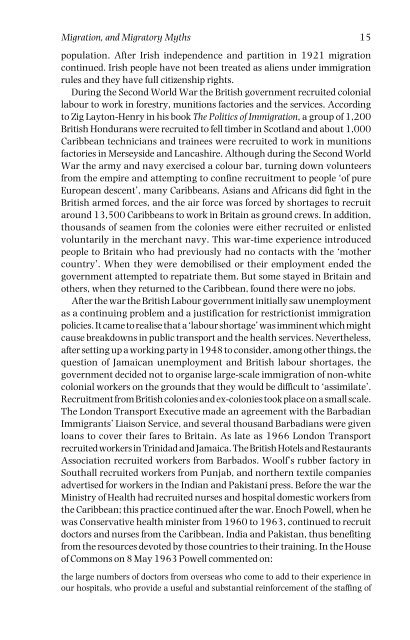Open%20borders%20The%20case%20against%20immigration%20controls%20-%20Teresa%20Hayter
Open%20borders%20The%20case%20against%20immigration%20controls%20-%20Teresa%20Hayter
Open%20borders%20The%20case%20against%20immigration%20controls%20-%20Teresa%20Hayter
Create successful ePaper yourself
Turn your PDF publications into a flip-book with our unique Google optimized e-Paper software.
Migration, and Migratory Myths 15<br />
population. After Irish independence and partition in 1921 migration<br />
continued. Irish people have not been treated as aliens under immigration<br />
rules and they have full citizenship rights.<br />
During the Second World War the British government recruited colonial<br />
labour to work in forestry, munitions factories and the services. According<br />
to Zig Layton-Henry in his book The Politics of Immigration, a group of 1,200<br />
British Hondurans were recruited to fell timber in Scotland and about 1,000<br />
Caribbean technicians and trainees were recruited to work in munitions<br />
factories in Merseyside and Lancashire. Although during the Second World<br />
War the army and navy exercised a colour bar, turning down volunteers<br />
from the empire and attempting to confine recruitment to people ‘of pure<br />
European descent’, many Caribbeans, Asians and Africans did fight in the<br />
British armed forces, and the air force was forced by shortages to recruit<br />
around 13,500 Caribbeans to work in Britain as ground crews. In addition,<br />
thousands of seamen from the colonies were either recruited or enlisted<br />
voluntarily in the merchant navy. This war-time experience introduced<br />
people to Britain who had previously had no contacts with the ‘mother<br />
country’. When they were demobilised or their employment ended the<br />
government attempted to repatriate them. But some stayed in Britain and<br />
others, when they returned to the Caribbean, found there were no jobs.<br />
After the war the British Labour government initially saw unemployment<br />
as a continuing problem and a justification for restrictionist immigration<br />
policies. It came to realise that a ‘labour shortage’ was imminent which might<br />
cause breakdowns in public transport and the health services. Nevertheless,<br />
after setting up a working party in 1948 to consider, among other things, the<br />
question of Jamaican unemployment and British labour shortages, the<br />
government decided not to organise large-scale immigration of non-white<br />
colonial workers on the grounds that they would be difficult to ‘assimilate’.<br />
Recruitment from British colonies and ex-colonies took place on a small scale.<br />
The London Transport Executive made an agreement with the Barbadian<br />
Immigrants’ Liaison Service, and several thousand Barbadians were given<br />
loans to cover their fares to Britain. As late as 1966 London Transport<br />
recruited workers in Trinidad and Jamaica. The British Hotels and Restaurants<br />
Association recruited workers from Barbados. Woolf’s rubber factory in<br />
Southall recruited workers from Punjab, and northern textile companies<br />
advertised for workers in the Indian and Pakistani press. Before the war the<br />
Ministry of Health had recruited nurses and hospital domestic workers from<br />
the Caribbean; this practice continued after the war. Enoch Powell, when he<br />
was Conservative health minister from 1960 to 1963, continued to recruit<br />
doctors and nurses from the Caribbean, India and Pakistan, thus benefiting<br />
from the resources devoted by those countries to their training. In the House<br />
of Commons on 8 May 1963 Powell commented on:<br />
the large numbers of doctors from overseas who come to add to their experience in<br />
our hospitals, who provide a useful and substantial reinforcement of the staffing of


